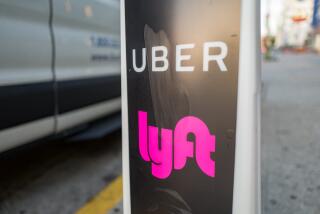Self-driving tech attracts investors, but Uber still relies on its drivers

- Share via
Former Uber Chief Executive Travis Kalanick once blamed the high cost of each ride on the “other dude in the car” — the driver. It has long been on the ride-hailing company’s road map to someday replace its vast workforce of contractors with self-driving vehicles, lowering fares and increasing profits.
But even Uber acknowledges that that won’t happen any time soon.
The world’s biggest ride-hailing firm, which began trading on public markets Friday, lost $3 billion in 2018 and expects losses to “increase significantly in the foreseeable future,” according to regulatory filings. That’s because looming questions remain about the technological progress of Uber’s self-driving car software, regulations surrounding autonomous vehicles and flying taxis, and the commercial viability of both efforts.
Despite its mounting losses, Uber’s most promising businesses continues to be its core ride-hailing business as well as other ventures that require human drivers, such as its food delivery service, Uber Eats, and its freight logistics arm, Uber Freight.
The company has adjusted its thinking about the role drivers will play in the self-driving future. Should self-driving vehicles flood the streets, Uber now believes it may always need some humans behind the wheel to help meet demand. But profitability will remain a challenge so long as it continues to split the fare from every ride with contractors while also pouring money into incentives for drivers and discounts for riders — tactics Uber relies on to fend off competition.
Uber now hopes it can grow to a scale where the volume of rides will help sustain the business, allowing it to fully dominate markets without big expenditures on rider discounts or driver incentives. That’s a tough prospect in places like the U.S., where Uber has to compete with rival Lyft’s prices.
Since competition is something of an inevitability, investors look to a self-driving future. Uber, for its part, believes autonomous vehicle technologies “have the long-term potential to provide safer and more-efficient rides and deliveries to consumers, as well as lower prices,” according to regulatory filings.
To that end, Uber poured $457 million into research and development efforts for their advanced technology products in 2018, which include its self-driving cars and flying cars.
“It’s hard to make the case they get to profitability if you do not believe in their autonomous vision and that they’ll be successful as a clear No. 2 player to the likes of Waymo,” said Dan Ives, an analyst for Wedbush securities, referring to Alphabet’s self-driving vehicle arm. “It’s a linchpin to the broader Uber vision around where they can take the distribution ecosystem over the coming years.”
But, Uber’s self-driving unit has hit a number of speed bumps. The company spent much of 2017 fighting and later settling a lawsuit from Alphabet over the alleged theft of trade secrets. In 2018, an Uber test vehicle operating in autonomous mode struck and killed a woman crossing the street in Tempe. In response, the company pulled all of its test cars off the road for nine months. Uber has since resumed testing, but nearly a year of lost time marked a significant setback in the face of steep competition from Waymo and others.
“In the aftermath [of the crash], Uber really had all the signs that they were cutting corners and were trying to push it to market faster than it should be going,” said Paul Sagawa, an analyst at SSR. “The investigation around that fatality … reveals a company whose technology is well behind, years behind Google’s in terms of its ability.”
Uber has now offloaded some of the operating costs as well as some of the development of its self-driving technology in a deal with Toyota, Softbank and other companies. The companies led a $1-billion investment into a newly spun-out division, called Uber Advanced Technology Group. Toyota committed to contributing an extra $300 million over the next three years to help cover costs.
As for the company’s electric vertical take off and landing vehicles, referred to many by the misnomer “flying cars,” Uber isn’t building the vehicles but focusing instead on batteries and creating a network for bookings. The company has set deadlines, hoping to begin testing vehicles by next year and launch a commercial service by 2023.
Those deadlines are incredibly ambitious, according to experts. Flying cars face a number of obstacles even compared to the nascent self-driving vehicle market, namely a shortage of pilots, according to Susan Shaheen, co-director of the Transportation Sustainability Research Center at UC Berkeley.
“An established base of users does not exist, and for the foreseeable future the aircraft will be piloted for a variety of reasons,” Shaheen said. “Even if there is overwhelming demand for air taxi services, in the early years the market will be limited by the number of available pilots, available skyport infrastructure, and the cost of providing a piloted service.”
The aggressive timeline for what Uber calls its Elevate division is part of a pre-IPO narrative woven to cast the firm as a forward-looking company, several sources told The Times. Company chief operating officer Barney Harford said in a 2018 interview that showing that Uber was “able to deliver multiple growth engines” was a “really important story” for investors.
But, as Harford indicated, Uber is more focused on its current operating businesses — all of which continue to rely on drivers in its current iteration.
“For the Elevate team, it is the absolute No. 1 priority,” Harford said in 2018. “For me as COO, it’s not the No. 1 priority. I’m more focused on the operating businesses we’re in today.”
It’s not hard to understand why. Uber’s core ride-share service has seen its growth slow quarter over quarter, but revenue from these services grew to $9.2 billion in 2018 from $3.5 billion in 2016. Lyft reported $2.2 billion in total revenue in 2018.
Uber Eats, which launched three years ago, saw $7.9 billion in gross bookings in 2018, $2.6 billion of which in the last quarter. Total revenue from Uber Eats in 2018 amounted to $1.46 billion. Compare that to competitor Grubhub, which saw $5.1 billion in a metric called gross food sales that includes the “total value of food, beverages, taxes, prepaid gratuities, and any delivery fees processed.”
Uber’s freight logistics service, which matches truck drivers with loads, saw $359 million in gross bookings in 2018. That year, revenue from Uber’s “other bets,” which mostly consists of its Freight service, was $373 million.
Efforts to automate all or part of these transactions may be ongoing, but Uber and other companies have come around to the idea that they’ll likely continue to rely on drivers for much of it. Even with self-driving, Uber says that “there will be a long period of hybrid autonomy, in which autonomous vehicles will be deployed gradually against specific use cases while Drivers continue to serve most consumer demand.”
“Drivers are therefore a critical and differentiating advantage for us and will continue to be our valued partners for the long-term,” regulatory filings read.
Twitter: @jmbooyah








